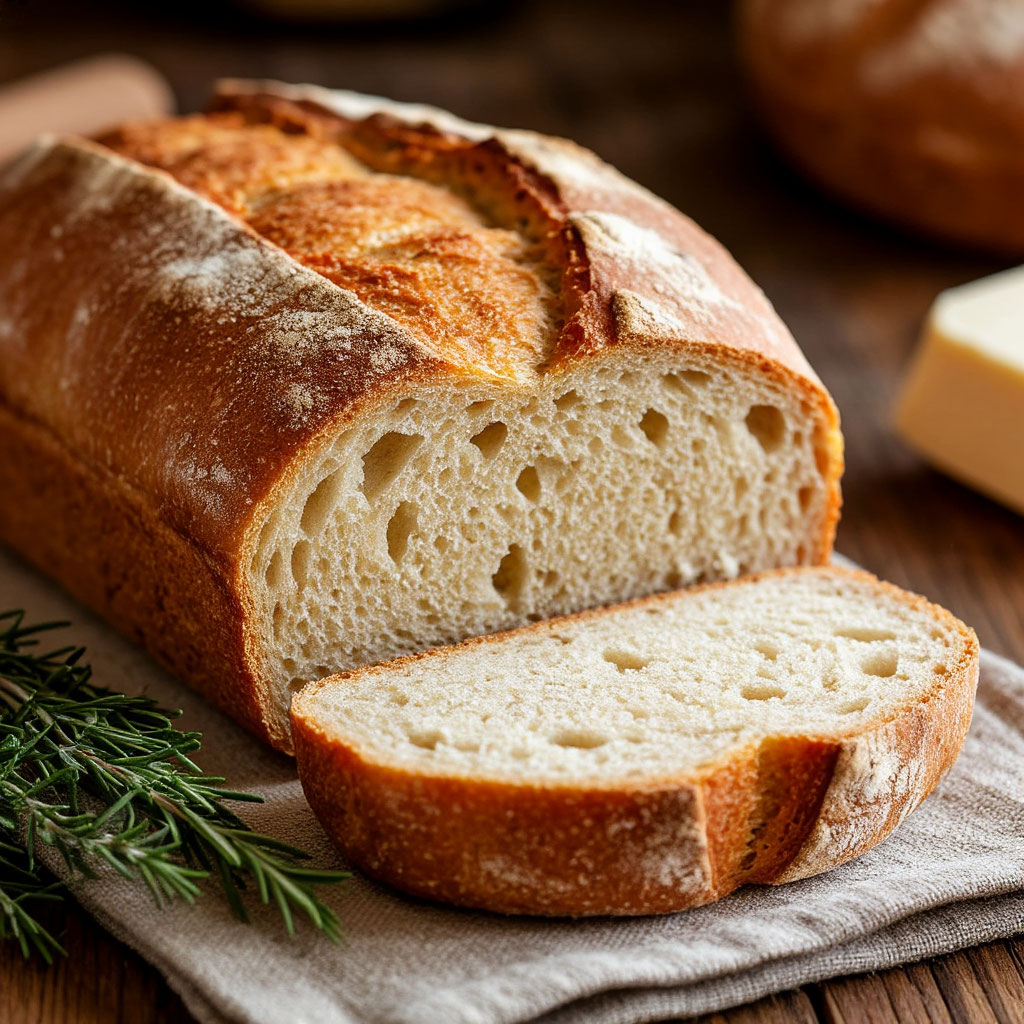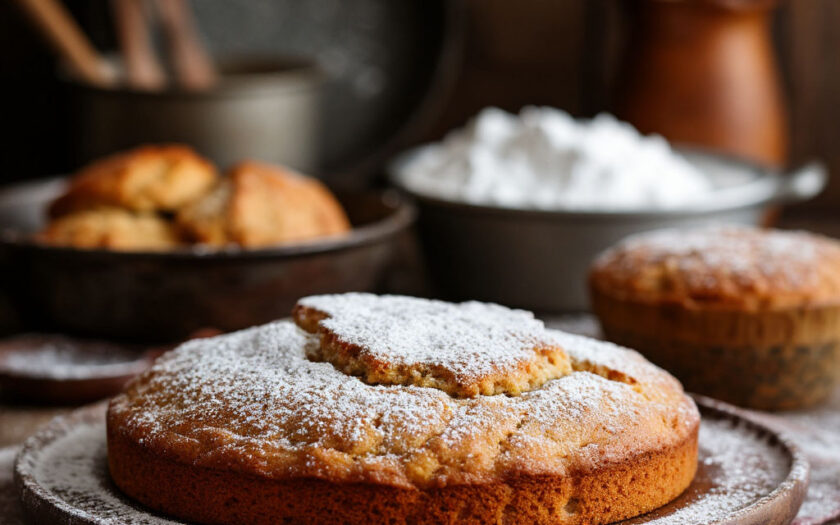In villages, bread and baked goods hold a special significance—every loaf is imbued with the warmth of the baker’s hands, the fragrance of the oven, and generations of family tradition. This is why rustic baking evokes comfort and serenity, transporting us back to childhood.
Homemade and heartfelt, these baked goods carry the unique essence of country life—its simplicity and natural ingredients. Here, we’ll explore traditional rural recipes from scratch.
Core Ingredients of Rustic Cuisine
True country cooking relies on humble, seasonally available staples:
Grains: Rye flour, wheat flour, oats.
Dairy: Milk, sour cream, butter.
Fruits & Berries: Apples, raspberries, currants, cherries.
Vegetables: Potatoes, carrots, cabbage.
Spices & Herbs: Salt, sugar, honey, bay leaf, garlic.
From Scratch Rustic Baking Recipes
Simple Peasant Bread
Simple peasant bread is one of the most popular types of rustic baking, a symbol of hospitality and home warmth. Its recipe is straightforward, yet it is precisely what makes this bread so delicious and wholesome. Let’s go through the process step by step so that everyone can enjoy the taste of authentic bread in their farmhouse kitchen.

Ingredients for Simple Peasant Bread:
- Wheat flour — 500 g
- Warm water — about 300 ml
- Fresh yeast — 20 g
- Sugar — 1 tbsp
- Vegetable oil — 1 tbsp
- Salt — 1 tsp
Step 1. Activating the Yeast
First, prepare the yeast mixture. Take a small bowl and dissolve the fresh yeast in a small amount of warm water (about half a cup). Add a tablespoon of sugar and stir gently until the sugar dissolves. Then, set the bowl aside for 10–15 minutes to activate the yeast. During this time, a frothy layer will form on the surface—this means everything has been done correctly.
Step 2. Forming the Dough
Pour the prepared yeast mixture into a large, deep bowl. Add the remaining warm water, sifted flour, salt, and a tablespoon of vegetable oil. Start mixing the dough with a spoon, gradually combining the ingredients. Once it becomes difficult to stir with a spoon, switch to kneading by hand.
Knead for about 7–8 minutes until the dough no longer sticks to your hands or the bowl. It should become soft and elastic.
Step 3. Letting the Dough Rise
Place the kneaded dough back into a clean bowl, lightly dusting the bottom with flour or adding a little vegetable oil to prevent sticking. Cover the bowl with a clean kitchen towel and place it in a warm, draft-free spot. The optimal ambient temperature should be around +25…+30 °C. Usually, one hour is enough for the dough to double in size.
To speed up the rise, you can place the bowl near a heated stove or oven, but be careful not to overheat it!
Step 4. Final Preparation Before Baking
Gently press down the risen dough with your hands to release excess air. Now shape the dough into your desired form—round, oblong, or any other convenient shape. If you plan to bake multiple loaves at once, divide the dough and shape individual loaves.
Then, transfer the shaped bread onto a baking tray lined with parchment paper or a wooden board dusted with flour. Cover it again with a cloth and let the dough rest for another 30 minutes. This ensures a better crumb structure and a smooth, beautiful crust.
Step 5. Baking the Bread
Preheat the oven to 200 °C in advance. Before placing the bread inside, lightly brush the top with water or a milk wash and sprinkle with coarse salt for a crispy crust. You can also make a shallow crosswise cut with a knife for an attractive pattern on the surface.
Bake the bread for about 30–40 minutes. To check for doneness, insert a wooden skewer into the center—if it comes out dry, the bread is ready. The top should turn a golden-brown color.
Cabbage Pies from Scratch
Traditional cabbage pies are a beloved rustic dish that is quick and easy to make. They have a bright, savory flavor and work perfectly as both a standalone treat and a side for lunch or dinner. Let’s take a closer look at how to prepare them.

Ingredients for Baking
For the dough:
- Wheat flour — 500 g
- Warm milk — 250 ml
- Chicken egg — 1
- Fresh yeast — 20 g
- Sugar — 1 tbsp
- Butter — 50 g
- Salt — ½ tsp
For the filling:
- Fresh white cabbage — 500 g
- Onion — 1 large
- Medium carrot — 1
- Vegetable oil — 2 tbsp
- Salt, ground black pepper — to taste
Step-by-Step Instructions for Cabbage Pies
Stage 1. Preparing the Dough
Dissolving the Yeast
Take a small bowl and dissolve the fresh yeast in half a cup of warm milk, adding a teaspoon of sugar. Stir until fully dissolved and let the mixture sit for 10–15 minutes until the yeast activates and a foamy layer forms.
Kneading the Dough
In a large, deep bowl, whisk the egg with a fork and add the remaining warm milk. Pour in the activated yeast mixture and mix well. Gradually add the flour, mixed with salt, stirring continuously until a smooth, firm dough forms.
The rolled-out dough should be stretchy, so it’s important that it remains pliable. After incorporating all the ingredients, work in the softened butter and knead the dough by hand again to achieve the perfect consistency.
Cover the bowl with a damp towel and place it in a warm spot for 1–1.5 hours, allowing the dough to rise at least double in size.
Stage 2. Preparing the Filling
While the dough rises, prepare the filling, which will give the pies their signature juiciness and tangy flavor.
Prepping the Vegetables
Finely shred the cabbage with a sharp knife or a mandoline slicer. Dice the onion finely and grate the carrot on a coarse grater.
Sautéing the Cabbage
Heat a skillet with two tablespoons of vegetable oil. First, sauté the diced onion until translucent, then add the carrot and cook for another couple of minutes. Next, add the shredded cabbage, season with salt and pepper to taste, and stir.
Cook the vegetables over medium heat for about 15–20 minutes, stirring occasionally, until the cabbage softens and develops a pleasant aroma. Let the filling cool to room temperature to prevent it from melting the dough when shaping the pies.
Stage 3. Shaping the Pies
Place the risen dough on a floured surface. Pinch off small pieces (about the size of a golf ball), roll them into neat balls, and then flatten them with a rolling pin into thin rounds, about 5 mm thick.
Place a tablespoon of the cooled cabbage filling in the center of each round, spreading it evenly. Carefully pinch the edges together, shaping the pies into half-moons.
Stage 4. Baking the Pies
Preheat the oven to 180°C (350°F). Line a baking sheet with parchment paper or a silicone mat and arrange the pies with some space between them so they can expand freely.
Brush the tops with an egg wash (egg beaten with a little water) for a glossy, golden-brown finish.
Bake the pies in the hot oven for about 20–25 minutes, until they turn golden and develop a crisp, inviting crust.
Enjoy your homemade rustic cabbage pies—warm, fragrant, and full of traditional flavor!
Homemade Rustic Sweet Pie from Scratch
A classic recipe for traditional rustic sweet pie that our grandparents have been famous for since olden times. This dessert combines wonderful lightness with the sweet aroma of apples and spices, making it the perfect addition to any family table.

For the dough:
- Wheat flour — 3 cups (~450 g)
- Large eggs — 2
- Granulated sugar — 1 cup (~200 g)
- Butter — 100 g
- Baking powder — 1 tsp
- Baking soda — ¼ tsp, quenched with vinegar
- Plain yogurt — 100 ml
- Pinch of salt
For the filling:
- Tart apples (preferably Antonovka) — 3–4 large
- Sugar — 3 tbsp
- Lemon juice — 1 tbsp
- Ground cinnamon — 1 tsp
Step 1. Preparing the Dough
Prepare all ingredients. Take the butter out of the fridge beforehand to soften.
Using a mixer or whisk, beat the eggs with sugar until light and fluffy.
Add yogurt and whisk again until well combined.
Sift the flour with baking powder, baking soda, and a pinch of salt. Gradually add the flour mixture to the egg mixture, gently folding with a spatula in upward motions to keep the dough airy.
Mash the softened butter with a fork and incorporate it into the dough in small pieces, mixing until smooth.
The resulting dough will be quite sticky and slightly tacky to the touch.
Step 2. Preparing the Filling
Peel and core the apples, then slice them into medium-thick wedges.
Place the apple slices in a separate bowl and drizzle with lemon juice to prevent browning.
Sprinkle with sugar and cinnamon, then gently toss to coat.
Step 3. Assembling the Pie
Preheat the oven to 180°C (350°F).
Grease a baking dish (preferably ceramic or glass) with butter and lightly dust with flour.
Spread half of the dough evenly over the bottom of the dish to form the base.
Arrange the apple slices in an even layer over the dough.
Pour the remaining dough over the apples, smoothing the top gently.
Step 4. Baking
Bake the pie for 40–50 minutes until golden brown. Check for doneness by inserting a toothpick—if it comes out clean, the pie is ready.
Carefully remove from the oven and let it cool slightly in the dish.
Once cooled, the pie can be dusted with powdered sugar or drizzled with honey. Serve warm or chilled with hot tea or milk.
Homemade rustic baking brings back cherished childhood memories, moments with loved ones, and cozy family gatherings. Bread or fragrant pies made from scratch bring warmth and joy to those you love, becoming part of your family traditions. Try one of these recipes and see for yourself!





